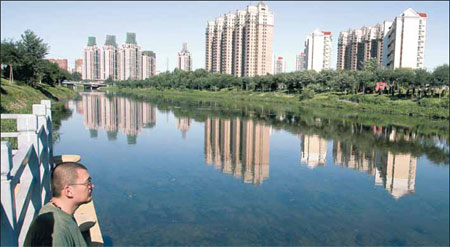Beijing sewage plants lag behind
City's rapid population growth has 'far exceeded infrastructure capacity'
Untreated waste is spilling into the capital's rivers, a fact that city authorities openly acknowledge.
The capacity of sewage disposal plants in Beijing is far behind the rapid rate of urban development in the capital, especially around the rural-urban fringe zone.
In many places, polluted water is directly discharged into rivers without treatment, according to the Beijing Environmental Protection Bureau.
Statistics from the Beijing Water Authority show that only 83 percent of the city's wastewater is treated, with the remaining 17 percent discharged into rivers without treatment.
The population of the city has far exceeded infrastructure capacity, said Han Yongqi, director of the management office of water and ecological environment at the bureau.
The city's water pollution treatment facilities are based on the city's population hitting 18 million by the end of 2020, he said.
However, the pace of growth has been seriously underestimated. The capital's population exceeded 20 million last year, according to the city's statistics bureau.
An investigation into the quality of surface water in the capital, released by the Department of Environmental Protection at the North China Center for Environmental Inspectors in early August, found all its 50 rivers, except nine that had run dry, were polluted.
In addition to ammoniacal nitrogen pollution, which affects some 35 percent of the city's rivers, chemical oxygen demand and phosphorus pollution are common, according to the report.
Treating the surface water pollution is no easier than tackling air pollution in the city, said an insider from the Beijing Water Authority, who spoke on condition of anonymity.
Wastewater treatment plants only cover around 60 percent of some densely populated regions, especially the urban-rural fringe zones, according to the investigation. At some farms, the excrement of animals is discharged into the rivers, it said.
Han said the source of water pollution is mainly domestic wastewater and the discharge problem is especially serious in urban areas.
The Qinghe River, a 23.6-kilometer-long waterway in the northern part of the city, is basically a foul-smelling sewer, with untreated waste discharged directly into it.
The number of residents in the Qinghe area soared from 800,000 to 2.9 million from 2003 to 2011.
The sewage plants located along the riverside are overwhelmed. According to the city's water authority, the government has been enlarging the capacity of sewage treatment plants since 2007, yet is has so far been unable to match the growth in residents.
According to Han, the government's continuing efforts should result in a great improvement in the city's water quality over the next three years.
However, considering the pace of urban development and the present water pollution levels, it may take some time for all the city's rivers to reach an acceptable standard.
|
Qinghe River has become foul-smelling as the sewage plants along the riverside are overwhelmed and untreated waste is discharged directly. Wang Jing / China Daily |



















